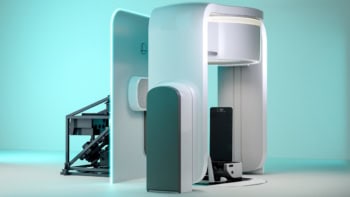
A wearable brain-scanning device that will provide high-resolution images of the whole brain, while the subject is moving about and performing everyday activities, is being developed by researchers in the US. The new approach – called ambulatory microdose positron emission tomography (AMPET) – miniaturizes positron emission tomography (PET) technology, such that it fits onto a helmet that’s worn during scanning.
Clinical brain imagers currently require a trade-off between motion and resolution. Large, bolted-to-the-floor devices – for techniques such as PET, magnetic resonance imaging (MRI) and magnetoencephalography (MEG) – provide high-resolution images but require the participant to remain completely still. Meanwhile, approaches such as electroencephalography and near-infrared spectroscopy can be used with a moving subject, but have low spatial resolution and cannot visualize important structures such as the hippocampus and amygdala deep within the brain.
“Standard PET scanners in hospitals utilize large photomultiplier tubes; but recent advances in material science have led to the development of detectors using silicon photomultiplier (SiPM) technology, which is orders of magnitude more compact,” says Julie Brefczynski-Lewis, from the West Virginia University (WVU) Centers for Neuroscience. Brefczynski-Lewis and colleagues built a ring of SiPM detectors that go around the head and are now in the process of developing this into a wearable PET scanner.
Portable PET
Stan Majewski, the original principal investigator on the project, explained that the team’s motivation for developing the portable PET brain scanner lay both in the challenge and the assumption that improved instruments will offer new opportunities. Following the development of such technology for rats – wearable Rat-Cap PET imagers – built at Brookhaven National Laboratory, and the development of the so-called PET-Hat in Japan, where the patient is in an upright position, but still has to remain motionless, Majewski’s “vision was to free the patient/subject and make him/her stand or even walk within a limited space”.
Initial simulations of the device showed that the helmet scanner offers more than a 400% increase in sensitivity over a conventional whole-body PET scanner. AMPET also requires a much lower radiation dose than conventional scanners. “The detectors are close to the head and thus capture more photons,” says Brefczynski-Lewis, who presented the team’s work at the recent Neuroscience 2015 annual meeting.
“We have already demonstrated that we can reconstruct images from this close geometry using 10–25% of the dose used for standard PET,” she adds. “Low dose has advantages both in reducing radioactivity exposure – making longitudinal scans, purely research scans and scans using young populations more feasible – as well as allowing detection of lower concentration targets like rarer neuron types and ligands with a low binding efficiency.”
Applications abound
Last year, the WVU team and its collaborators were awarded $1.5m through the newly set up BRAIN Initiative from the National Institutes of Health. While still in the prototype stage, AMPET has a wide variety of potential research and clinical applications, including studies of balance, physical therapies, natural social interactions and virtual reality, as well as disorders such as stroke, Alzheimer’s and Parkinson’s disease, multiple sclerosis and traumatic brain injury.
“Imagine imaging a savant while painting or a chess master in action: we might be able to tap into the mechanisms behind these super abilities,” says Brefczynski-Lewis. “Clinically, we may better understand why people with autism react differently to social situations and this may inform diagnosis and therapies. Moving forward, we’ll be talking with researchers and clinicians working in stroke rehabilitation, Parkinson’s disease and balance disorders, as well as neuroscientists who study social, cognitive and emotional processes, to determine how such a scanner could be used and what features are most necessary.”
“I was excited to discover that the system can potentially assist with early diagnosis of Alzheimer’s by combination with virtual reality,” adds Majewski. “Apparently, the earliest signs of Alzheimer’s are not seen in the memory loss but in the loss of navigational skills. Well-controlled navigational tests in the virtual-reality environment, correlated with functional/molecular images of the brain obtained at low radiation dose with our upright high-resolution PET imager, can be really revolutionary.”
- A version of this article first appeared on medicalphysicsweb.org



